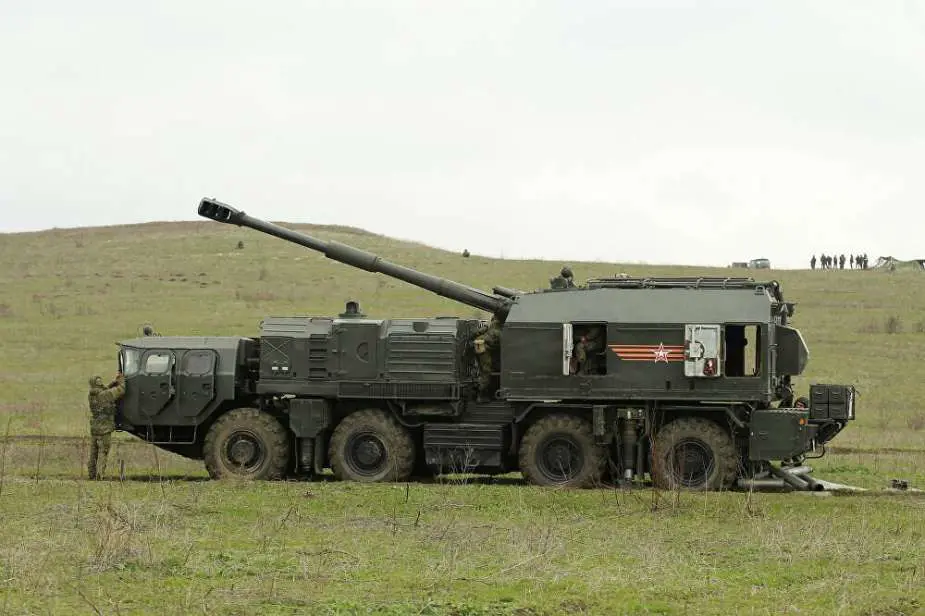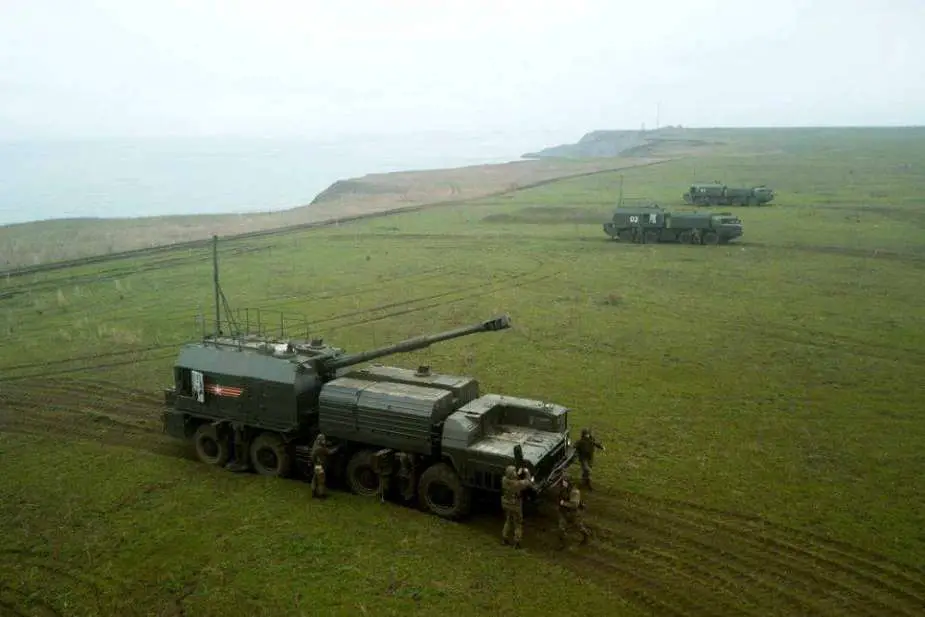Breaking news
Russia deploys A-222 Bereg self-propelled coastal howitzer in Ukraine for the first time.
According to several Russian media outlets on March 22, 2024, Russia plans to re-establish the Dnieper River Flotilla for the sixth time since its initial inception in 1737. An informed source within the Russian Ministry of Defense revealed that this new unit will comprise marine and special forces units. For the first time, it will also include the A-222 Bereg self-propelled 130mm coastal howitzer, which has not been deployed in Ukraine since February 2022.
Follow Army Recognition on Google News at this link

The A-222 Bereg, a 130mm coastal artillery system developed by the Soviet Union, can engage maritime targets moving at high speeds up to 100 knots (over 180 km/h). (Picture source: Russian social media)
Dmitry Boltenkov, a Russian military expert, reports that the updated flotilla is expected to be equipped with a variety of naval vessels, including river minesweepers, armored boats, artillery boats, and landing crafts. This composition is expected to follow historical Russian naval practices, suggesting the integration of diverse marine units into what is likely to be organized as a separate battalion. The array of the flotilla's operations is projected to reflect military tactics employed by the USSR during World War II. Activities are anticipated to include engagement with adversary vessels, troop deployments, and the establishment of strategic footholds along the Dnieper River through the creation of bridgeheads and, where feasible, the crossing of the river, which parallels the strategic actions taken in 1943.
The introduction of the A-222 Bereg artillery units within the flotilla is intended to augment Russia's strategic capabilities in the Dnieper region and adjacent territories. This approach also aims to counter naval assistance provided to Kyiv by allies such as Sweden and the Netherlands. Boltenkov's insights suggest a calculated move by Russia to deter foreign naval military support to Ukraine and to re-establish its dominance in the Dnieper region.
The re-establishment of the Dnieper Flotilla by Russia, as announced on March 20, 2024, by Defense Minister Sergei Shoigu, concludes a prolonged debate regarding the necessity and role of such a flotilla within the Russian Armed Forces, highlighting its perceived strategic value. The re-establishment of the Dnieper flotilla by Russia can be viewed through both historical and strategic lenses. Historically, the Dnieper flotilla has been reformed several times since its initial creation in 1737, underlining the strategic significance of river fleets in controlling vital waterways, which are essential for transportation and supply during conflicts. The flotilla has played roles in various historical contexts, notably in World War II, where it supported military operations along the Dnieper River, showcasing the river's strategic value in facilitating movement and logistics.
The Dnieper Flotilla has been established at least five times throughout history, reflecting the Russian strategic relevance to operations on Ukraine's riverways. Initially formed on January 4, 1737, following a Senate decree, the flotilla has seen various incarnations, notably being reassembled in 1788 under commanders such as American John Paul Jones and Frenchman Charles Henri Nicolas Otho de Nassau-Siegen. It actively participated in historical events such as the naval battle near Ochakov. Subsequent formations occurred in response to specific military needs, such as during the Civil War and World War II, indicating a pattern of reactivation during periods of conflict. Post-World War II developments led to the flotilla's disbandment and its assets being repurposed, contributing to the establishment of a river division in Pinsk, Belarus, post-USSR dissolution.
The reintroduction of the Dnieper Flotilla occurs in a context where regional security dynamics, particularly concerning Ukraine, have shifted. The establishment of naval forces by Ukraine on the Dnieper in response to the conflict with Russia is reflective of broader military and strategic calculations, where the Dnieper River remains a significant geographical and strategic asset, and the presence of a specialized flotilla enhances any army's capabilities related to mobility, supply, and operational flexibility along this key waterway. Consequently, the reintroduction of the Dnieper flotilla is indicative of Russia's strategic aims and operational priorities in the face of current resupply challenges and operational objectives in the Dnieper region.

A standard operational unit usually comprises six to eight A-222 Bereg units along with a mobile command post and one or two support vehicles. (Picture source: Russian social media)
The A-222 Bereg is a coastal artillery system developed by the Soviet Union, aimed at defending coastlines against potential amphibious assaults. Initiated in the late 1970s, its design focuses on a self-propelled capability to engage both large and small maritime targets quickly over significant distances. These targets include vessels moving at high speeds up to 100 knots (over 180 km/h), but also land-based targets. The system is based on an 8x8 MAZ-543M truck chassis, equipped with a turret that houses a 130mm AK-130 cannon. This artillery piece is capable of rotating 240 degrees and elevating from -5 to +50 degrees, allowing for a maximum firing range of 27 km. The cannon can utilize both standard and laser-guided projectiles, features semi-automatic loading, and has a firing rate of 10 to 12 rounds per minute. Operational use requires a crew of eight.
The Bereg incorporates an auxiliary power unit, composed of two diesel generators, which provides energy to all systems when the main engine is turned off, whether for stealth reasons or to conserve fuel. This feature is part of the system's design to maintain readiness and operational efficiency without reliance on the primary engine.
The A-222 Bereg's design enables it to be deployed rapidly to coastal areas potentially vulnerable to unexpected landings, with its target detection radius of up to 30 km. The system can start firing within three to five minutes of reaching an unprepared position, facilitated by the deployment of four hydraulic jacks for stabilization. Despite its heavy weight of 43.7 tons and a relatively modest maximum speed of 60 km/h, attributed to its 525 horsepower diesel engine, the Bereg's 8x8 chassis affords a degree of off-road capability suitable for varied terrain, supplemented by a central tire inflation system for better mobility on soft grounds. Additionally, the system can be transported by large military cargo aircraft such as the Antonov An-22 Antey and the Ilyushin Il-76.
A standard operational unit, or battery, usually comprises six to eight A-222 Bereg units along with a mobile central post equipped with the MP-195 control system, and one or two support vehicles for combat duty, providing energy (two units of 30 kW), a mini-canteen, and auxiliary equipment. Each vehicle includes a 7.62-mm turret machine gun mount and is mounted on an MAZ-543M 8x8 truck chassis. The setup allows for independent operation with firing data shared between units positioned up to 1,000 meters apart. The command vehicle can track up to four targets simultaneously, enabling the battery to engage two targets at once, and can operate autonomously for up to a week. Though the A-222 Bereg system was finalized in 1988 and entered service testing in the early 1990s, it was officially adopted into service in 1996. However, there were concerns about the system's 130mm caliber since the Russian military predominantly uses artillery of 122mm and 152mm calibers.























